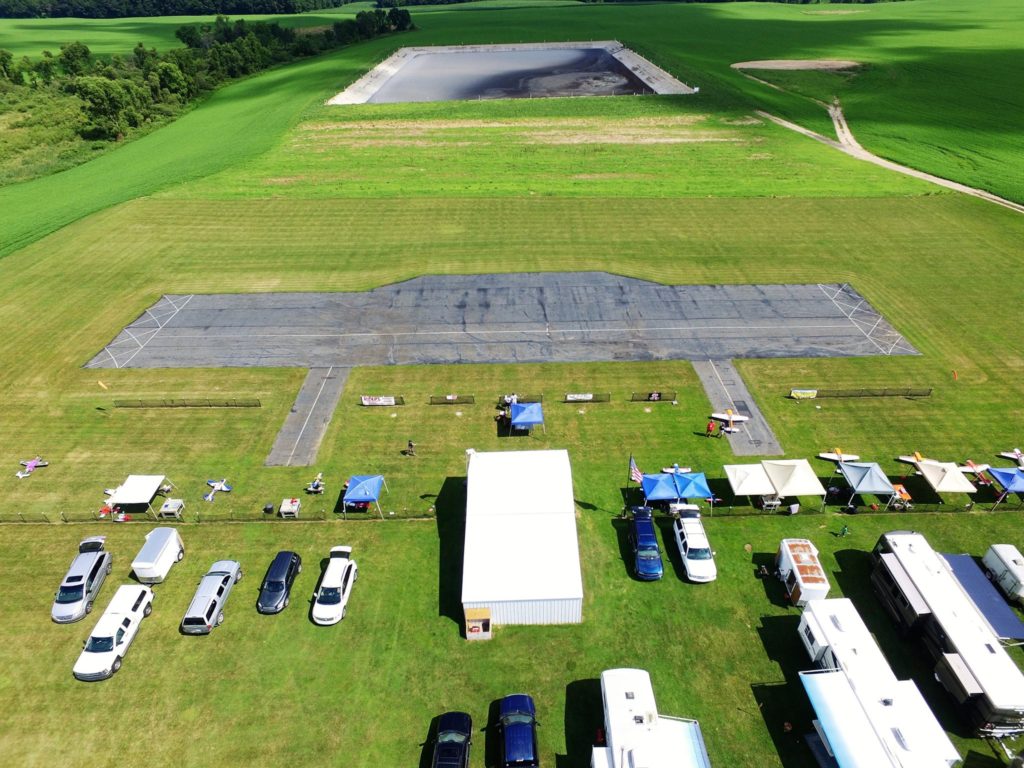1. What size is your fabric runway?
78’ wide x 296’ long with (2) 20’ x 40’ taxi ways.
2. What preparation is needed before laying the fabric?
We rolled the ground and mowed the grass as short as possible. You can kill the grass off with spray to help the fabric lay down faster.
3. How is it installed?
It is held down by 8” staples approx. 6” apart at all edges and seams.
4. What maintenance is required during the season?
The only maintenance required has been to kill a few weeds working up thru the seams and to patch a few bad prop strikes.
5. What needs to be done each spring?
Roll the field and push the staples down. They work up a little due to the frost in the ground.
6. Any winter preparation needed?
No winter prep has been needed.
7. How easy is it to repair?
We repair holes using small pieces of the fabric and asphalt roof patching compound. Some of the smaller holes can be repaired using just the asphalt roof patching.
8. How long has your fabric been down?
Since 2006
9. How is it repaired?
See question # 7.
10. What glues have you used and what works best?
Again, see question # 7.
11. How long will it last?
We are guessing 6 years in Michigan, but a club in Texas has had it for five (5) years and they expect it to last much longer.
12. How are the rolls seamed?
The seams are just stapled down at approx 6” spacing
13. What are the top three problems with the fabric runway?
(A) Short coupled planes or planes with poor landing gear tend to be real squirrely at taxiing and take off.
(B) You must have a very slow idle.
(C) If a plane noses in or crashes on the runway real hard, it can put the prop nut thru the runway or the prop may slice thru. However most of the time it does no harm.
14. Why did the club go to a fabric runway?
We went to the runway because a lot of the guys did not like having to put larger Wheels on their airplanes in order to take off from the tall grass, especially in the spring when the grass grows so fast.
Advantages:
Even small electrics can take off with no problems, as well as fuel powered scale planes with retracts.
Disadvantages:
See Question # 12 – ALSO sometimes extremely small tail wheels may catch in a seam while taxiing.
15. How do the club members like the fabric runway?
Most of them like it, (Even those who originally opposed it). We also maintain approx two (2) acres of mowed field for anyone who still prefers to fly off grass.
16. What do jets do to it? How many members fly jets?
Currently, no one regularly flys jets off our field, but we have been told that they do not affect it.
17. What care must be taken while mowing? How close do you get to the fabric?
Our mower just overlaps the edges of the runway and has had no problems.
18. How have you oriented your runway to the prevailing wind?
Our runway runs east to west. The reason for making it so wide was to allow pilots to angle into the wind on extremely windy days which we get a lot of in the spring and fall.
19. Do you know other clubs that have used the fabric?
There are several other clubs that we know of, One of our club members flys off one in Texas every winter and we contacted a club in Wisconsin before putting ours in.
20. Does it stay tight?
The Runway material stretches tight in the sunshine and stays tight all year round.
21. What are your rules when flying from your fabric runway?
These are OUR runway specific rules. We have been rather loose on 1 & 2 unless there happens to be a lot of flying activity.
22. Does the wind damage the runway?
We have not had any problem with the winds damaging the runway. But, we have securely installed the runway with special staples.
KRAM RUNWAY RULES:
1. The fabric runway and the airspace above the runway are to be kept open at all times for takeoff and landing. No hovering or hanging directly over the runway.
2. All flying including high speed passes and 3 D flying should be conducted north of the runway
3. Hand Launching of any tractor type aircraft or any other aircraft that may damage the runway, must be done to the north of the runway.
4. The landing of any tractor style aircraft without landing gear, must be done in the grass North of the runway.
RUNWAY INSTALLATION
One of our members made up four (4) tools for putting the Staples in. They are made of square steel tubing sized to fit the staples diagonally and a plunger to push them out. With one worker loading them, and another driving them in, it goes surprisingly fast. We just rolled the fabric out and pulled it out fairly flat before stapling it down. In a few hours of warm sunshine the fabric stretches tight. It will be a little fluffed up for about 2 weeks until the grass underneath dies down. But it is useable within a couple of hours. It takes a lot of staples, as well as approx ten (10) stakes with large washers/strip for the ends to hold them in place while rolling the fabric out and stretching it. We had the whole runway done in approx four (4) hours with about 20 members working on it.
Hope I answered most of your questions. If you need more info, send me a list of what info you need and I will see what I can do for you.
Kent Radio AeroModelers, Inc.
Danny Osborn
Former President

